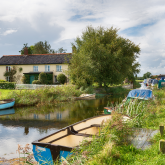COUNTRYSIDE STEWARDSHIP AND BEYOND
Published 26 September 2020
 This September marks the end of a busy window for countryside stewardship applications. At the beginning of the year farmers were urged to consider applying, in order to benefit from favourable returns and a fixed source of income for five years. The message certainly seemed to hit home, with a mix of applications, from those new to environmental schemes altogether and those seeking to replicate expired agreements.
This September marks the end of a busy window for countryside stewardship applications. At the beginning of the year farmers were urged to consider applying, in order to benefit from favourable returns and a fixed source of income for five years. The message certainly seemed to hit home, with a mix of applications, from those new to environmental schemes altogether and those seeking to replicate expired agreements.
Towards the end of the year, as the Agriculture Bill enters its final stages, we hope to have a series of statements and consultations which will reveal a more detailed picture of what the next few years will entail.
At the moment we know that applications for countryside stewardship will remain until 2023, after which it is mooted that a ‘stepping stone’ (currently dubbed the Sustainable Farming Incentive or SFI) may be introduced to bridge the gap between the end of the Basic Payment scheme and the start of ELMS.
An article on the BBC website this week reported concern from environmentalists that an ‘easy-to-enter’ SFI scheme could reward farmers for normal good practice, such as ‘conserving soil’ or ‘keeping pesticides out of streams’. Such activities shouldn’t, in their opinion, be funded by the tax-payer.
But for smaller farms in particular the SFI could bring short-term relief for those who are worried that the new ELMS ‘whole farm management’ approach won’t generate sufficient income to keep them in business. Good soil management, the protection of water courses, and the management of hedgerows and trees all contribute to the maintenance of the English countryside for public enjoyment; these measures cost farm businesses money, so why shouldn’t public funding make a contribution?
In contrast to the forecast simplicity of the SFI, ELMS looks set to be made up of a tiered approach. The scheme will pay for measures that are above regulation: much of cross compliance remains in legislation, and the government may take the opportunity to introduce other baseline measures.
Earlier this week the NFU, along with the TFA, CLA, LEAF and the Sustainable Food Trust, set out their proposals for how the new ELM scheme should work. The key to a successful scheme? Optimising the efficient use of resources through capital investment and land management measures, and offering incentives for introducing complementary, holistic measures across the whole farm.
You wouldn’t be blamed for thinking that this sounds familiar, with criticism levied at DEFRA that the new scheme will bear more than a passing resemblance to old agri-environment schemes. As always, the devil will be in the detail, and we await with bated breath the White Paper containing the full plans, to be released later this autumn.
Share this story
Arnolds Keys Blog

Messing about on the river
18 September 2020
‘Messing about on the river…’ For those of us who remember this famous line from the song written by Tony Hatch, which was lyrically adapted for the Hoseasons television advert... Read more >

The residential property market in Norfolk is bouyant
15 September 2020
Despite Covid, and the uncertainties over jobs, the economy and Brexit - and even despite the furore created by the Stamp Duty holiday – fundamentally the residential property market in... Read more >

BUOYANT DEMAND FROM TENANTS AND STAMP DUTY HOLIDAY MAKE NOW A GREAT TIME TO INVEST
11 September 2020
Two new reports have revealed that demand for properties in the private rental sector, has hit a record high. This is in turn putting pressure on rents, as demand exceeds supply. Read more >

GREEN - NO LONGER DEFRA’S FAVOURITE COLOUR?
25 August 2020
In July DEFRA announced that EU rules on greening measures will be scrapped from 2021, marking a significant change to the rules which have been in place since 2015. Read more >
